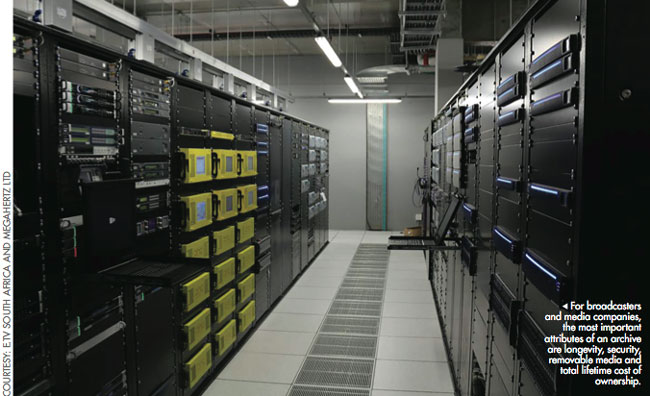Broadcast News
08/06/2016
Tapeless Archiving Made Easy

For more than 30 years, data tape in one form or another was the most logical choice for archiving media across various industries. Tape offered the capacity that early hard disks lacked, and although tape media and tape drives both had their fair share of problems, tape archives could be made secure by creating two independent copies of each file on different tapes.
The idea of replication did not translate to the hard disk world and RAID quickly became preferred for its ability to aggregate together the capacity and bandwidth of an array of small disks to provide a useful amount of fast storage. More importantly, it came with a self-healing capability to protect against disk failures.
Fast forward to 25 years and we have witnessed disk capacities increasing from 1 TB to 10 TB in a cat and mouse race against increasing data tape capacities. Today disks have the edge on capacity, but tape cartridges have the edge on cost. However, the important question to ponder here is – for how long? The demands of the cloud and big-data data storage are driving the cost and capacity of both. But it is reasonable to assume that a non-linear medium will ultimately be the winner.
Today's high capacity 8 TB and 10 TB disks offer excellent cost and capacity. Nonetheless, two fundamental issues have to be addressed to create a secure and cost effective media archive.
Power Costs and Security
As recently as five years ago, popular opinion was that hard disks would never be able to compete with tape, due to the cost of the power they used and the cost of the air conditioning to get rid of the heat they dissipated. On the face of it, this seems to be an insurmountable problem, compared with a tape library, where the recording media is passive.
Turning to the security aspect, it became evident that RAID itself was the Achilles' heel. In one form or another, RAID is still predominantly the technique used for online disk storage, albeit sharing the top tier with increasingly affordable solid state storage.
With any well-designed RAID, the risk of loss is very low when the individual disks are small, but the vulnerability increases with disk capacity. Even a dual fault-tolerant RAID can expose media assets to catastrophic loss for a window of up to 10 days. The moral of the story is – don't assume that RAID necessarily means that it is 'secure'. Clustered storage and Object storage get around the problem and as a result they dominate the Nearline market, neatly dividing the tier in terms of performance and cost, offering more choices for the system designer working to a budget.
Replication Re-emerges
Replication has also re-emerged for Online Cloud storage, and Offline Archives, providing the highest levels of security and unlocking the potential of even lower cost Shingled Magnetic Recording (SMR) disks. But here again the technology branches into two subtly different forms, which has a very big impact on Archive Storage.
Replication for the Cloud is based on segmenting the files and storing the segments in geographically separated locations. This diversity means the data will survive a disk failure or even an entire data center failure.
Offline Disk Archives – An Alternative to Data Tape
For broadcasters and media companies, the most important attributes of an archive are longevity, security, removable media and total lifetime cost of ownership (TCO). Non-segmented Replication ticks all those boxes by creating two identical copies of each complete media file, on different hard disks. These Offline Disk Replicas can be in the same enclosures at the TV station, or distributed between geographically separated locations on a wide area network.
Since the files are not segmented, individual disks can be removed for various reasons – be it shelf storage, transportation or disaster recovery. This technique also allows the disks to be fully spun down and stopped, with individual disks
ALTO is a simple storage implementation using non-linear disks to replace the linear tape media spinning-up to archive or restore files on demand with a latency of seconds, rather than minutes, even for the largest petabyte-class configurations.
Spinning down the disks overturns the historical power consumption objection and greatly extends the life of the disk drives which are more likely to clock up 10 to 100 hours per year rather than 8750 hours per year for traditional disk storage.
Practical Implementation
ALTO from Disk Archive Corporation is a simple implementation of a tried and tested storage concept using non-linear disks to replace the linear tape media, bringing important performance and business benefits for broadcasters and media companies alike. This solution makes a compelling business case for organizations in this domain considering an investment in media archive storage, making it more attractive in commercial, operational and technical terms:
• Commercial case: A media archiving solution built around ALTO's modular storage technology will have a significantly lower TCO compared to alternative solutions. The savings result directly from ALTO's low power consumption and greatly extended disk life. Indirectly, there are benefits from lower maintenance costs and greatly reduced downtime.
• Operational case: ALTO offers broadcast and media companies an archiving solution capable of supporting many more concurrent users with faster access to media assets. An ALTO disk takes 15 seconds to spin-up and begin to restore data. Once online, it offers random access to media assets out-performing the sequential access to linear data tape archives.
• Technical case: ALTO is very easy to install and use. A key factor is the much greater tolerance that disks exhibit to temperature, humidity and atmospheric pollutants than data tapes. Best practice suggests that temperature and humidity should be carefully controlled, and the environment should be dust-free to achieve a reasonable tape and tape drive life, but in the real world, this can be a challenge. ALTO is far less susceptible to environmental factors than a data tape library and that translates to lower build cost and lower operating costs.
For difficult environments, Helium filled disk drives provide a totally inert environment for the disk platters. Helium also reduces internal turbulence, spin-up time and power consumption. This was esoteric technology just twelve months ago. Now Helium filled disks are available off the shelf, with little or no price premium. There is no equivalent technology for data tape.
ALTO takes advantages of new developments in disk drive technology driven, in turn, by the economies of scale of the storage industry to deliver innovative and cost effective solutions for Broadcasters and Media companies worldwide.
Image credit: ETV South Africa and Megahertz Ltd.
www.diskarchive.com
(JP/LM)
The idea of replication did not translate to the hard disk world and RAID quickly became preferred for its ability to aggregate together the capacity and bandwidth of an array of small disks to provide a useful amount of fast storage. More importantly, it came with a self-healing capability to protect against disk failures.
Fast forward to 25 years and we have witnessed disk capacities increasing from 1 TB to 10 TB in a cat and mouse race against increasing data tape capacities. Today disks have the edge on capacity, but tape cartridges have the edge on cost. However, the important question to ponder here is – for how long? The demands of the cloud and big-data data storage are driving the cost and capacity of both. But it is reasonable to assume that a non-linear medium will ultimately be the winner.
Today's high capacity 8 TB and 10 TB disks offer excellent cost and capacity. Nonetheless, two fundamental issues have to be addressed to create a secure and cost effective media archive.
Power Costs and Security
As recently as five years ago, popular opinion was that hard disks would never be able to compete with tape, due to the cost of the power they used and the cost of the air conditioning to get rid of the heat they dissipated. On the face of it, this seems to be an insurmountable problem, compared with a tape library, where the recording media is passive.
Turning to the security aspect, it became evident that RAID itself was the Achilles' heel. In one form or another, RAID is still predominantly the technique used for online disk storage, albeit sharing the top tier with increasingly affordable solid state storage.
With any well-designed RAID, the risk of loss is very low when the individual disks are small, but the vulnerability increases with disk capacity. Even a dual fault-tolerant RAID can expose media assets to catastrophic loss for a window of up to 10 days. The moral of the story is – don't assume that RAID necessarily means that it is 'secure'. Clustered storage and Object storage get around the problem and as a result they dominate the Nearline market, neatly dividing the tier in terms of performance and cost, offering more choices for the system designer working to a budget.
Replication Re-emerges
Replication has also re-emerged for Online Cloud storage, and Offline Archives, providing the highest levels of security and unlocking the potential of even lower cost Shingled Magnetic Recording (SMR) disks. But here again the technology branches into two subtly different forms, which has a very big impact on Archive Storage.
Replication for the Cloud is based on segmenting the files and storing the segments in geographically separated locations. This diversity means the data will survive a disk failure or even an entire data center failure.
Offline Disk Archives – An Alternative to Data Tape
For broadcasters and media companies, the most important attributes of an archive are longevity, security, removable media and total lifetime cost of ownership (TCO). Non-segmented Replication ticks all those boxes by creating two identical copies of each complete media file, on different hard disks. These Offline Disk Replicas can be in the same enclosures at the TV station, or distributed between geographically separated locations on a wide area network.
Since the files are not segmented, individual disks can be removed for various reasons – be it shelf storage, transportation or disaster recovery. This technique also allows the disks to be fully spun down and stopped, with individual disks
ALTO is a simple storage implementation using non-linear disks to replace the linear tape media spinning-up to archive or restore files on demand with a latency of seconds, rather than minutes, even for the largest petabyte-class configurations.
Spinning down the disks overturns the historical power consumption objection and greatly extends the life of the disk drives which are more likely to clock up 10 to 100 hours per year rather than 8750 hours per year for traditional disk storage.
Practical Implementation
ALTO from Disk Archive Corporation is a simple implementation of a tried and tested storage concept using non-linear disks to replace the linear tape media, bringing important performance and business benefits for broadcasters and media companies alike. This solution makes a compelling business case for organizations in this domain considering an investment in media archive storage, making it more attractive in commercial, operational and technical terms:
• Commercial case: A media archiving solution built around ALTO's modular storage technology will have a significantly lower TCO compared to alternative solutions. The savings result directly from ALTO's low power consumption and greatly extended disk life. Indirectly, there are benefits from lower maintenance costs and greatly reduced downtime.
• Operational case: ALTO offers broadcast and media companies an archiving solution capable of supporting many more concurrent users with faster access to media assets. An ALTO disk takes 15 seconds to spin-up and begin to restore data. Once online, it offers random access to media assets out-performing the sequential access to linear data tape archives.
• Technical case: ALTO is very easy to install and use. A key factor is the much greater tolerance that disks exhibit to temperature, humidity and atmospheric pollutants than data tapes. Best practice suggests that temperature and humidity should be carefully controlled, and the environment should be dust-free to achieve a reasonable tape and tape drive life, but in the real world, this can be a challenge. ALTO is far less susceptible to environmental factors than a data tape library and that translates to lower build cost and lower operating costs.
For difficult environments, Helium filled disk drives provide a totally inert environment for the disk platters. Helium also reduces internal turbulence, spin-up time and power consumption. This was esoteric technology just twelve months ago. Now Helium filled disks are available off the shelf, with little or no price premium. There is no equivalent technology for data tape.
ALTO takes advantages of new developments in disk drive technology driven, in turn, by the economies of scale of the storage industry to deliver innovative and cost effective solutions for Broadcasters and Media companies worldwide.
Image credit: ETV South Africa and Megahertz Ltd.
www.diskarchive.com
(JP/LM)
Useful Links
Top Related Stories
Click here for the latest broadcast news stories.
20/03/2014
Singing Praises: Disk Archive And ALTO Architecture
Established in 2009, Disk Archive Corporation specialises in developing and supporting high capacity, high availability solutions for long-term storag
Singing Praises: Disk Archive And ALTO Architecture
Established in 2009, Disk Archive Corporation specialises in developing and supporting high capacity, high availability solutions for long-term storag
14/03/2023
Big Pic Media Helps Build ELMNTL
Big Pic Media has announced its role in helping build London's latest creative studio, ELMNTL. The Shoreditch facility is built around a host of cloud
Big Pic Media Helps Build ELMNTL
Big Pic Media has announced its role in helping build London's latest creative studio, ELMNTL. The Shoreditch facility is built around a host of cloud
12/11/2014
Helium? Shingles? What's That Got To Do With Archiving?!
It's human nature to judge the new in terms of what we already know, especially when an innovation challenges established concepts, writes Alan Hoggar
Helium? Shingles? What's That Got To Do With Archiving?!
It's human nature to judge the new in terms of what we already know, especially when an innovation challenges established concepts, writes Alan Hoggar
12/01/2024
Taking Back Control Of Your Archive Easily And Securely
For many years, we have been fed the line 'Use the cloud' but in actual fact, has anyone looked at the cost of using the cloud or the robustness and c
Taking Back Control Of Your Archive Easily And Securely
For many years, we have been fed the line 'Use the cloud' but in actual fact, has anyone looked at the cost of using the cloud or the robustness and c
12/12/2017
Broadcasters & Post Production Facilities Digitising Legacy Tape Formats: Pt 4
The fourth in a series of articles by Pat Horridge of VET Training covering the issues facing broadcasters & post houses needing to digitise legacy ta
Broadcasters & Post Production Facilities Digitising Legacy Tape Formats: Pt 4
The fourth in a series of articles by Pat Horridge of VET Training covering the issues facing broadcasters & post houses needing to digitise legacy ta
06/02/2023
EditShare Implements Storage And Media Management Platform
EditShare® has implemented a comprehensive storage and media management platform for Last Cut Media, based in Abu Dhabi, United Arab Emirates. The sys
EditShare Implements Storage And Media Management Platform
EditShare® has implemented a comprehensive storage and media management platform for Last Cut Media, based in Abu Dhabi, United Arab Emirates. The sys
22/08/2022
Danmon Asia Completes Expanded Digital Media Storage
Danmon Asia has announced the completion of expanded digital media storage for Ba Ria - Vung Tau Radio & Television (BRT) which broadcasts across sout
Danmon Asia Completes Expanded Digital Media Storage
Danmon Asia has announced the completion of expanded digital media storage for Ba Ria - Vung Tau Radio & Television (BRT) which broadcasts across sout
31/05/2022
EditShare Provides Media Storage To Antel
EditShare® is providing powerful media storage and workflow facilities to Administración Nacional de Telecomunicaciones (Antel), the national telecoms
EditShare Provides Media Storage To Antel
EditShare® is providing powerful media storage and workflow facilities to Administración Nacional de Telecomunicaciones (Antel), the national telecoms
26/05/2022
Avid NEXIS® Media Storage Solution Now Available As A Subscription Offering
As unveiled during its 2022 Investor Day event at the Nasdaq MarketSite in New York City, Avid® has made its award-winning Avid NEXIS® media storage s
Avid NEXIS® Media Storage Solution Now Available As A Subscription Offering
As unveiled during its 2022 Investor Day event at the Nasdaq MarketSite in New York City, Avid® has made its award-winning Avid NEXIS® media storage s
27/10/2021
3P Invests In EditShare's FLOW Media Management And EFS Storage Solutions
EditShare® has announced that Brisbane's leading production/post-production facility, 3P Studio (3P) has expanded its investment in EditShare’s FLOW m
3P Invests In EditShare's FLOW Media Management And EFS Storage Solutions
EditShare® has announced that Brisbane's leading production/post-production facility, 3P Studio (3P) has expanded its investment in EditShare’s FLOW m
04/12/2017
Broadcasters & Post Production Facilities Digitising Legacy Tape Formats: Pt 3
Broadcasters & Post Production Facilities Digitising Legacy Tape Formats The third in a series of articles by Pat Horridge of VET Training covering th
Broadcasters & Post Production Facilities Digitising Legacy Tape Formats: Pt 3
Broadcasters & Post Production Facilities Digitising Legacy Tape Formats The third in a series of articles by Pat Horridge of VET Training covering th
19/04/2023
Universal Tennis Selects M2A Media's Live IP Transport Product
M2A Media has announced that Universal Tennis has chosen M2A Media's live IP transport product, M2A CONNECT, to automate, optimize, and manage the tra
Universal Tennis Selects M2A Media's Live IP Transport Product
M2A Media has announced that Universal Tennis has chosen M2A Media's live IP transport product, M2A CONNECT, to automate, optimize, and manage the tra
18/04/2023
TrackIt Achieves AWS Media & Entertainment Competancy Status
TrackIt has announced that it is one of the first partners to achieve the AWS Media & Entertainment Competency status. This latest recognition confirm
TrackIt Achieves AWS Media & Entertainment Competancy Status
TrackIt has announced that it is one of the first partners to achieve the AWS Media & Entertainment Competency status. This latest recognition confirm
18/04/2023
Globecast Partners With Brklyn-Media
Globecast has formed a strategic partnership with New York City-based Brklyn-Media, provider of virtualized media management and infrastructure servic
Globecast Partners With Brklyn-Media
Globecast has formed a strategic partnership with New York City-based Brklyn-Media, provider of virtualized media management and infrastructure servic
06/10/2022
Gravity Media Promotes Jamie Brewer To Director - Media Services And Facilities
Gravity Media has promoted Jamie Brewer to Director – Media Services and Facilities across the EMEA region. In his new role, Jamie will be responsible
Gravity Media Promotes Jamie Brewer To Director - Media Services And Facilities
Gravity Media has promoted Jamie Brewer to Director – Media Services and Facilities across the EMEA region. In his new role, Jamie will be responsible















